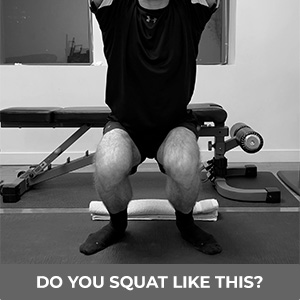I discovered how to fix the most common ankle and foot issues with posture promoting exercises. Foot pain from flat feet. Knee pain from toes pointed outwards. Poor balance, agility, and recurrent ankle injuries gone. All fixed by correcting lower leg posture. What causes poor ankle and foot posture? Can corrective exercises fix it? And what exercises can you do to prevent issues like these? Well, let’s get into it!
Pronation Distortion Syndrome
Postural and muscular misalignments cause issues. This is the case with our ankles and feet. Pronation distortion syndrome is defined by the feet pointing out, collapsed arches, and internal knee rotation. It doesn’t look normal. It decreases our athletic performance. And it raises our risk for lower leg injuries. Luckily, injuries with the Achilles, plantar fascia, and ACL can be reduced by correcting this. [1]
Pronation distortion syndrome is caused by some muscles being too weak. Specifically, the tibialis and intrinsic foot muscles. Others, too tight like the calves and plantar fascia. While I’ve never suffered from this syndrome, I’ve also never had foot and ankle issues. All my years of running, soccer, and basketball without injury or performance degradation. I don’t think this is a coincidence. Despite not having issues, I still follow this routine to prevent them. I’m all about optimizing posture for long-term health of muscles and joints. [1]
Corrective Posture Routine
When searching PubMed for answers, one study detailed this issue perfectly. A randomized controlled trial on the effect of corrective exercise for pronation distortion syndrome. Perfect. This study focused on balance and found significant improvements in the treatment group. No improvements in the control group. While the treatment group performed robust 60min exercise sessions over three months to correct pronation distortion syndrome, I think results can be achieved with less. This syndrome can have two variations. One stems from issues at the hip and another with the feet and ankle [2]. That study attempted to correct both at once. Here, I’m only concerned with the feet and ankle.
To see if you have this variation, perform an overhead squat in front of a mirror or camera. If your knees knock together and feet point out, you may have pronation distortion syndrome. Next, determine which variation. Elevate your heels an inch or two off the floor and perform the overhead squat again. If this fixed your knee and foot issues, this post is for you. The problem stems from your feet and ankles. Here is the exercise and stretch routine to fix it:
Inverted Calf Raises
These target the weak posterior tibialis muscles. Start standing with both feet rotated inward. Raise onto your toes, hold for a second, and return to the starting position. Perform this to near failure for two sets. Once you’re able to complete thirty repetitions, progress to elevated raises, and then one-legged raises.

Banded Toe Raises
If you don’t follow KneesOverToesGuy, then you’ve likely never tried strengthening your weak anterior tibialis muscles. He’s obsessed with growing big tibs. And rightfully so. I prefer doing banded toe raises to accomplish this. I sit on the floor, loop a resistance band around my foot and a pole, and perform toe raises to near failure for two sets. If you don’t have resistance bands, then heel walking is an alternative. Or moon walking, or star walking. Whatever floats your boat. Many times, I perform both. They seem to help mitigate my shin splints from running.

Toe Crunches
Lastly, toe crunches help build the foot’s arche and intrinsic foot muscles. Lie a towel on the floor underneath your foot. Arche your foot to scrunch the towel in. Focus more on the foot arche than the toe crunch. Perform until near failure for two sets. This exercise is good for running too. I need to incorporate it into my training more often.

Relevant Stretches
With the exercises completed to strengthen weak muscles, stretches are next to loosen tight ones. I perform both these stretches after every run. They’re ingrained in my stretching protocol. First, I do downward dogs for thirty seconds and two sets. This stretches tight calf muscles. Second, I do a kneeling fascia stretch for thirty seconds and two sets. This stretches tight plantar fascia. I alternate these stretches back and forth so the rest period of one stretch is a working set on the other.

Final Thoughts
I’ve never had ankle or foot issues, but this is likely from having good lower leg posture. If your feet point out, arches collapse, and knees knock then you should fix it. It’ll prevent future issues. Performing inverted calf raises, toe raises, and toe crunches will strengthen weak muscles. Downward dogs and kneeling fascia stretches will loosen tight ones. Performing this routine four times a week for four to eight weeks will yield measurable results. Despite not having issues, I perform all of them every week. These are my latest habits for health excellence.






